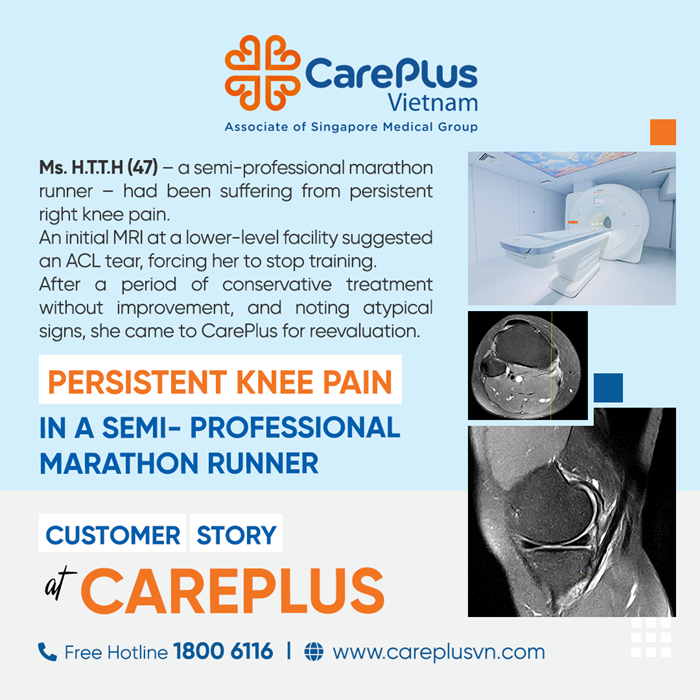PERSISTENT KNEE PAIN IN A MARATHON RUNNER

7/7/2025 1:29:26 PM
Ms. H.T.T.H (47 years old), a semi-professional marathon runner, came to CarePlus for an MRI scan after enduring persistent right knee pain for an extended period. The pain had started suddenly during a race event, without any specific traumatic incident, but it was severe enough to prevent her from completing her intended goal. An initial MRI at another facility suggested a possible anterior cruciate ligament (ACL) tear — a diagnosis that forced her to temporarily suspend all athletic activities. However, after a period of conservative treatment and rest, her pain did not improve, particularly around the medial and lateral aspects of the knee, despite normal walking ability and no signs of joint instability. Recognizing the atypical presentation for an ACL tear, she decided to visit CarePlus for a comprehensive reevaluation.
CLINICAL AND IMAGING ASSESSMENT: A COLLABORATIVE APPROACH TO ACCURATE DIAGNOSIS
At CarePlus, every knee MRI case is reviewed through a close collaboration between orthopedic specialists and radiologists. This is more than just multidisciplinary teamwork — it is a medical consultation process in which imaging is guided by clinical findings and image interpretation is tailored to specific patient symptoms.
In Ms. H.’s case, the orthopedic examination revealed a stable knee joint, no clinical signs of ACL rupture, and tenderness localized to the medial and lateral joint lines. Based on this clinical context, the medical team decided to expand the MRI protocol: additional T2-weighted sequences were obtained in two planes to thoroughly evaluate the ACL and rule out any tear, while attention was also directed to the tendons and muscle insertion points commonly affected in runners.
MRI FINDINGS
MRI of the right knee showed:
- Normal anterior and posterior cruciate ligaments.
- No evidence of meniscal tear or bone injury.
- Increased signal intensity at the deep insertion of the pes anserinus tendon on PDFS sequences — suggestive of chronic tendinopathy.
- Abnormal signal along the lateral knee with fluid accumulation in the deep bursa — consistent with iliotibial band syndrome (ITBS).
With this definitive diagnosis, the orthopedic specialist was able to deliver focused treatment: anti-inflammatory management for pes anserinus tendinitis and IT band syndrome, combined with physiotherapy and targeted stretching exercises designed specifically for runners. There was no need for prolonged training interruption or surgical intervention.
THE VALUE OF KNEE MRI: CLEAR DIAGNOSIS – AVOIDING UNNECESSARY INTERVENTIONS
In clinical practice, many cases of knee pain are misdiagnosed as ligament or meniscal tears, leading to delayed treatment and prolonged recovery. When appropriately indicated and performed with optimized sequences, MRI — in combination with thorough clinical examination — can clearly differentiate between tendon inflammation, overuse syndromes, cartilage damage, and ligament tears.
Even more critical is a multidisciplinary approach: clinicians who understand the pathophysiology of symptoms, and radiologists who grasp the technical aspects and diagnostic value of MRI sequences — working together to reach an accurate conclusion and ensure no injury is overlooked.
CONCLUSION
Ms. H.’s case is a clear example of the importance of accurate imaging interpretation within the right clinical context. At CarePlus, every MRI scan is not merely an image — it is a vital link in a comprehensive, precise, and practical approach to healthcare.
When used correctly, MRI not only detects injuries — it paves the way for sustainable recovery.